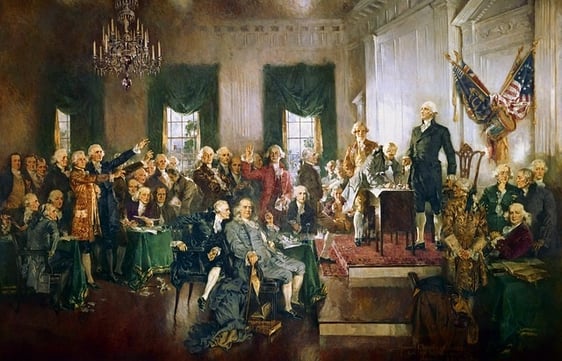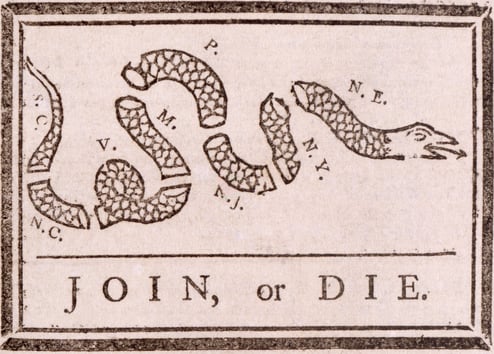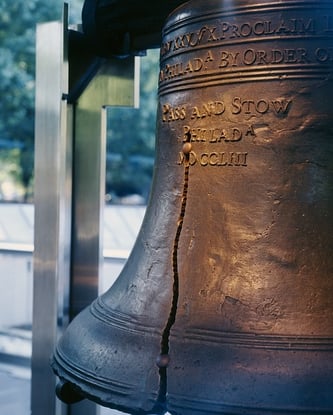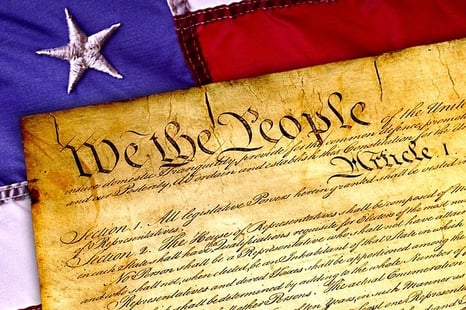Some Colonial and Revolutionary Families of North Carolina
You've likely heard of the 13 original colonies, merely how much exercise you know most them? When were they created, why were they created, how did they gain their independence, and which states did they go? In this guide, we comprehend all the important and interesting facts near the 13 colonies, including the official proper noun of each colony, when it was founded, and the office it played upwardly to and during the Revolutionary War. Nosotros also requite background on the colonies and explain how they somewhen became contained states. A colony is an area that is under the control of another country. In this case, the 13 colonies were located in North America, and they were controlled by Great britain. United kingdom of great britain and northern ireland had an all-encompassing history of colonization, and information technology wanted colonies in N America for multiple reasons, including to increment their trading opportunities, create new jobs, and bring in acquirement from colonial workers and appurtenances. Past 1775, the xiii colonies had a population of roughly 2.5 million people. Many of them had been born in the colonies and considered themselves "American." Afterward some failed colonies, such equally those at Roanoke Island, and the separate of Carolina into the colonies of Northward Carolina and South Carolina, there were at this point 13 colonies. It was these 13 colonies that rebelled against Corking Britain and eventually founded the United States of America (see the terminal section for more than information on how this happened). Beneath are the original thirteen colonies, separated into iii groups based on location: New England Colonies, Heart Colonies, and Southern Colonies. For each colony, we include its official name, the year information technology commencement became a colony of England, and the yr it became a crown colony (which meant information technology was officially controlled by the British regime, unlike regular colonies which sometimes had more than ability to self-rule). There'due south besides additional data on how each colony was founded and the role it played during the Revolutionary State of war. United states that were function of the 13 original colonies are colored crimson on this 13 colonies map. Source: Wikimedia eatables First established at Plymouth, Massachusetts by the Pilgrims, the New England Colonies were some of the primeval colonies, and they were primarily populated by British Puritans. Massachusetts Plymouth Colony, the first establishment forth the shores of Massachusetts Bay, was founded in 1620, and the number of settlers in the area continued to grow steadily subsequently its founding. The Massachusetts Bay Colony was founded in 1628 and developed a large merchant fleet. Both of these colonies became part of the Providence of Massachusetts Bay when information technology became a crown colony in 1692. In the lead upwardly to the Revolutionary War, as well every bit during it, Massachusetts was a cardinal colony, and many major events occurred there, including the Boston Massacre, the Boston Tea Party, and the battles of Bunker Hill, Concord, and Lexington. Rhode Island Colonists expelled from Massachusetts Bay due to their religious behavior were the first people to settle Rhode Island. They founded Providence as a site of religious freedom. In 1774, Stephen Hopkins, a Rhode Island pol, introduced a bill that prohibited the importation of slaves into the colony. It became the first anti-slavery law in the colonies. Connecticut Previously settled by the Dutch, Connecticut became a colony for British and colonial Puritans. The Connecticut Colony was an early defier of England's control and mobilized over twoscore,000 soldiers for the Revolutionary State of war. New Hampshire Named after the English county Hampshire, New Hampshire was settled as early as 1623. In 1638, colonist John Wheelwright was banished from Massachusetts colony and founded Exeter in what would later become New Hampshire. From 1641 to 1679, the Providence of New Hampshire was ruled by its boyfriend colony of Massachusetts. Source: Wikimedia commons The British got much of this area, now called the Mid-Atlantic, by capturing information technology from the Dutch. The fertile soil of these colonies allowed them to grow crops, particularly grains. Stiff timber, fe, and shipbuilding industries helped make these colonies major trade centers. They were also the most various, both ethnically and religiously, of all the British colonies. New York Formerly the Dutch province of New Netherland, New York was awarded to England during the Second Dutch-Anglo War and was renamed for the Duke of York. It was a major battleground during the Revolutionary War, and the final evacuation of the British Army from New York and render of Full general George Washington'due south army in 1783 was the crusade of a massive parade and celebration. New Jersey Another part of New Netherland that was surrendered to the British in 1664, the Providence of New Jersey was split in two (East Jersey and West Bailiwick of jersey) before condign a single royal colony in 1702. During the Revolutionary War, Full general Washington and his regular army spent much of their time in New Jersey, and it was Trenton, NJ they attacked after the famous crossing of the Delaware River. Pennsylvania Founded past British Quaker William Penn, Pennsylvania became a major economic and political center of the colonies. Famous colonial Pennsylvanians include Benjamin Franklin and Thomas Paine, and information technology was in Philadelphia that both the Declaration of Independence and the US Constitution were signed. Delaware Earlier 1776, this colony was known as the Lower Counties on the Delaware, and it was governed by the Province of Pennsylvania from 1682 until 1701. On December seventh, 1787, Delaware became the first country to ratify the United states of america Constitution. Located in what is now considered the Southern United States, the Southern Colonies had economies based heavily on the cash crops of cotton, rice, and tobacco. They also had significantly higher numbers of slaves than most of the other colonies. Maryland The colony's first ruler was the English Lord Baltimore, who established it every bit a haven for English language Catholics. During the lead upwards to the Revolutionary War, Maryland staged a tea party like to the more famous one which took identify in Boston. Virginia Jamestown, settled in 1607, was the first lasting British colony in North America; afterwards it became a crown colony, expansion continued speedily. Many of the nigh famous leaders of the Revolutionary War, including George Washington and Thomas Jefferson, came from Virginia, and information technology had one of the largest populations of the colonies. The final battle of the war was fought at Yorktown, Virginia, where the British surrendered in 1781. North Carolina North Carolina was the site of the failed Roanoke Colony, the first attempt at a permanent English settlement in North America. It was originally called the Province of Carolina, until it was split into the Provinces of N Carolina and Southward Carolina in 1712. The colony was a major site of tobacco cultivation. South Carolina Afterward being split from the Province of Carolina in 1712, South Carolina became ane of the wealthiest colonies in Northward America, due in function to its large cotton plantations and rice cultivation, so South Carolinian colonists were especially offended by the taxes Great Britain imposed on them. A significant amount of fighting during the Revolutionary War occurred within S Carolina, totaling over 130 battles. Georgia Subsequently gaining control of the expanse from the Spanish in the 1720s, the English language established Georgia equally a new colony in 1732. Information technology was the last of the 13 original colonies to exist established. Its first leader was British Full general James Oglethorpe, who hoped to create a haven for English people who had been imprisoned for debt. The cities of Savannah and Augusta especially saw heavy fighting during the Revolutionary War. The 13 original colonies' first major act of independence was forming the Postage Human action Congress in 1765. At this coming together, colonial leaders rejected the tax because they had no representatives in British Parliament (creating the phrase "no taxation without representation). Tensions between Slap-up Uk and the colonies steadily increased, fueled by incidents such equally the Boston Massacre in 1770 and the Boston Tea Party in 1773. The British striking back by passing a series of punitive laws and restricting cocky-government in the colonies. In belatedly 1774, a group of Patriot leaders at the Continental Congress meeting prepare their own government to resist Great Uk, and, on April 19, 1775, the beginning battles of the Revolutionary War were fought at Lexington and Hold. During the war, each of the xiii colonies formed a Provincial Congress to lead them, now that they no longer accepted the laws of Great britain. On July 4, 1776, the xiii colonies alleged themselves free and independent states at the 2nd Continental Congress by signing the Declaration of Independence. The Revolutionary State of war ended at Yorktown in October 1781, when Americans captured the British army there. On September 3, 1783, representatives from Slap-up Britain and American signed the Treaty of Paris, which officially ended the conflict and established America's complete separation from Dandy Britain. The 13 colonies were the grouping of colonies that rebelled against Great United kingdom, fought in the Revolutionary State of war, and founded the The states. Here'due south the thirteen colonies list: The Platt Subpoena was written during another fundamental fourth dimension in American history. Learn all about this important document, and how it is still influencing Guantanamo Bay, by reading our consummate guide to the Platt Amendment. Transcendentalism was a fundamental movement in 19th-century America, but many people still aren't sure what it was all nearly. Read our guide on transcendentalism for everything you demand to know about key transcendentalist behavior, an overview of the movement'south history, and key players. Writing a persuasive essay? We accept 113 ideas for persuasive essay topics to assistance get you started!
What Were the thirteen Colonies?
The 13 Original Colonies

New England Colonies

Heart Colonies

Southern Colonies

How Did the Colonies Proceeds Their Independence?
Summary: Thirteen Colonies
What'southward Adjacent?

About the Author
Christine graduated from Michigan State University with degrees in Environmental Biological science and Geography and received her Master's from Duke University. In high school she scored in the 99th percentile on the SAT and was named a National Merit Finalist. She has taught English and biology in several countries.
Source: https://blog.prepscholar.com/13-colonies
0 Response to "Some Colonial and Revolutionary Families of North Carolina"
Post a Comment